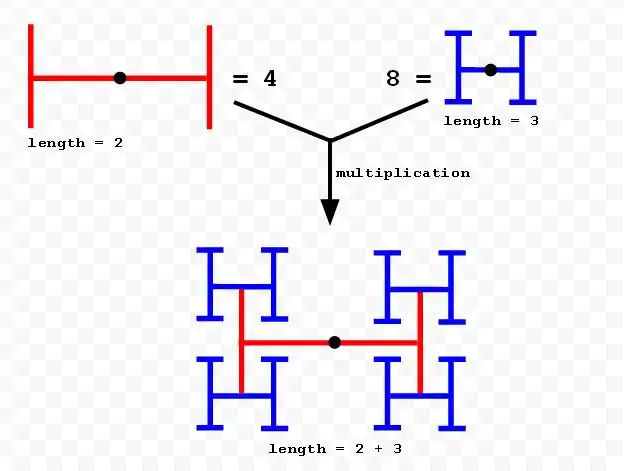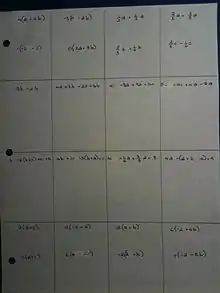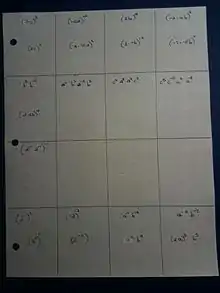There are about 20 algebraic identities if we count "=" uni-directionally as 2 identities. This shear mass can be overwhelming to children. KinderCalculus reduces these 20 to 3 generalized identities called Abbreviation, Sprolo, and Forq. The latter 2 are evert identities where the outer verb moves inward.
Abbreviations
"Abbreviations" are the generalized Combine-Like-Terms operations. "Abbreviation" is a long word and sometimes we will favor the more algorithmic initialism "Nevadab". Just as in languages where an abbreviation does not need justification, they don't need it here either because the identity follows immediately from the definition of the Self-ish verbs -- there's almost no brain work involved in proving it. The term Contraction is shorter and synonymous with abbreviation, but can also mean "simplify", so we avoid it.
In traditional algebra, "like terms" refer to addition of terms with similar powers like 3x^2 + 4x^2 = 7x^2. Here we consider a more general "like terms" criteria to include those with different powers but can be combined via multiplication instead of addition. We call this principle "Nevadab", which is an initialism for "neighboring-verbs, add depth, alike bases". The "b" in Nevadab is silent. The odd word is a poor attempt at forcing the initialism into something pronounceable like "nevada".
Under the Nevadab criteria, we can combine a^3 * a^4 into a^7. Combining these terms involve 3 steps:
- Check that the verbs are neighboring: the verbs +, *, ^ form a ascending complexity sequence of plus, self-plus, self-self-plus. Each successive pair are neighboring verbs. + and ^ are distant verbs, not neighboring.
- Check that the bases are alike: the bases in the 2 terms must be the same.
- Add depth: to combine the terms, simply add the depth
The diagram below illustrate the generalization in syntax diagram:
.
3a + 4a = 7a .
| .
| .
| .
+-----+-----+ .
| \ / | .
| o--*--o | .
| / \ | 3 3 .
3a * 4a -----+ equals +----- a + b .
(not neighbors) | | (irreducible) .
| --o-- | .
+-----+-----+ .
| .
| .
| .
3 4 7 .
a * a = a .
in the box, .
* = seed verb .
o = repeater verb .
(see the glossary for definitions) .
.
Sprolo
Sprolo are generalized distributive & factoring rules. Generalized factoring is called common-leftover "colo" and generalized distribution is called "spread", hence the term "sprolo". Below we generalize the distributive rule beyond the usual a(b+c) = ab + ac. This generalization simplifies the many distributive rules into one -- greatly simplifying algebra!
In the picture below, the center box represents the syntactic parse tree of the distributive expression. The diagonals are the Blead reverse-verb form of the distributive relation and the verticals are the Blead forward-verb form.
.
.
3(a + b) = 3a + 3b .
.
| .
(1) left divide | .. u + v u v .
is same as --> | --o = ----- = - + - .
right | .. d d d .
\ | / .
\ | / .
\ | / .
+-----+-----+ .
| \ / | .
| o--*--o | .
| / \ | .
| | 3 3 .
3a * 3b -----+ equals +----- a + b .
(uninteresting) | | (irreducible) .
| \ | .
| *--o-- | .
| / | .
+-----+-----+ .
/ | \ .
u v (2) / | \ .
o-- + o-- / | \ .
b b | .
= u*v | u*v d__ d__ u v .
log u + log v = o--- | ---o = V u * V v = --o * --o .
b b b | d d d .
| root(u) * root(v) .
.
3 3 3 .
(ab) = a b .
.
Notes: .
1. recall that for self-plus, left & right division reduces to plain division .
2. log poses a slight exception to the diagram, with + replacing * on the left.
.
u,v = leaf, lattice .
a,b = bases .
d = depth .
.
Forq
Forq stands for FOrward-Reverse seQuence.
| general form (*) | self-plus form | self-times form |
a O b a o---- = b I o-- c c " a ----o = --o O b c c |
ab a -- = b --- c c |
log a^b = b log a c c c___ c__ V a^b = (V a )^b |
log(ab) = log(a) + log(b)
Most people are confused as to why " * " is replaced with " + " when we spread log. When log is interpreted as the depth of a snow flake, the identity is easy to see:
In Blead terms, if we draw exponentials as snowflakes, then the log is the depth of the snowflake (the number of hops it takes to go from center to leaf). Multiplication of snowflakes means that we take the blue snowflake and paste it onto each leaf of the red. Because both snowflakes have the same bases, the resultant paste is a proper snowflake. The log of the resulting snowflake is, by definition, the hop count from center to leaf, which is 2+3.

log 4 + log 8 = log (red) + log (blue) = 2 + 3 = 5 = log of combined = log (4*8)
2 2 2 2 snowflake 2
Exercises
1. -4x + 3x
2. 4y + 3x
2 3
3. x * x
2 3
4. x + x
5 -2
5. -3a * 4a
5 -2
6. -3a + 4a
2 3
7. x * y
2 3
8. ( x )
1 1
9. --- x * - --- x
2 4
1 1
10. --- x + - --- x
2 4
Merge & write as fractions using Flopposites
-1 -1
11. 2a + a
-2 -1
12. a + a
1 -2 -1
13. - a * a
2
Exercises - Sprolo

